Barcelona 2023 – La Rambla street is main tourist street in Barcelona. It’s also called Las Ramblas
Updated February 2023
La Rambla street is the main tourist street in Barcelona and the most famous street. It is also called Las Ramblas because the street has different sections with different names. La Rambla goes from Plaça de Catalunya to the Port Vell marina of Barcelona. It is in the old city, called Cuitat Vella, and borders the Raval and the Gothic areas of the old city.
Las Ramblas is a popular place to stay for visitors to Barcelona due to the central location and lively atmosphere. Find hotels on Las Ramblas.
It is estimated that the street La Rambla has around 80 to 100 million pedestrians a year. The Spanish poet and friend of Salvador Dali, Federico García Lorca, once said, ‘It is only street in the world, which I wish would never end’. Lorca made that comment in the 1930ies and since then La Rambla has changed a lot. But we think he would still love it.
Today many visitors find La Rambla over-crowded with too many tourist shops. But La Rambla is still special and you can not really say that you have visited Barcelona.
On a sunny day La Rambla often looks like sea of people, when you gaze down it from Plaza Catalunya – but there is always room for one or two more.
One of the attractions of La Rambla is the people. Residents and tourists alike, it’s people make the Rambla special, so don’t miss a stroll down La Rambla to savour the atmosphere of this famous Barcelona walkway.
Pictures Las Ramblas
Best hotels Las Ramblas
The name La Rambla is thought to originate from the Arabic “ramla,” meaning “sandy ground.” This was the name of the waterway, or storm drain, where rainwater would flow from the hills of Tibidabo down to the sea after heavy rains. This waterway was outside the first medieval wall of Barcelona.
In the latter part of the 18th century the old medieval walls came down and the first buildings started appearing along the Rambla and the transformation into the tree lined avenue began.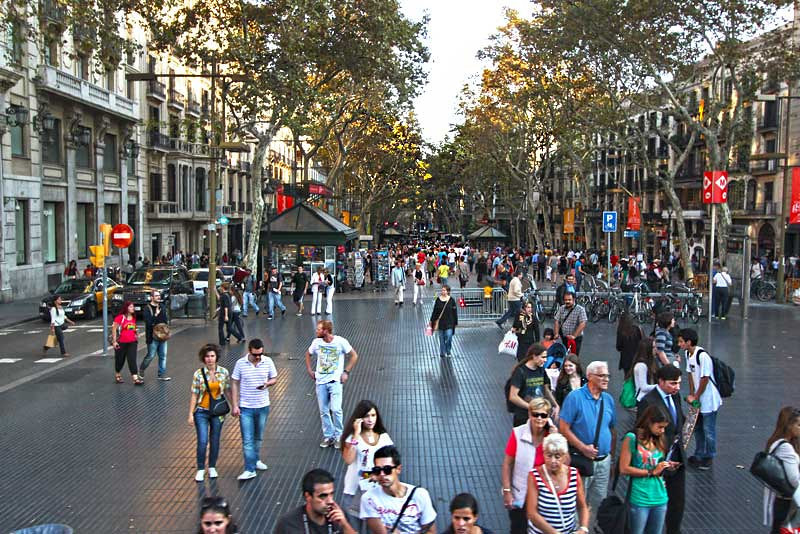
Today La Rambla, or La Ramblas if you prefer, is one of the biggest attractions of Barcelona and definately the most crowded street in the city. It is is buzzing with the sights, sounds and smells of cafés, flower shops, street artists, tourists and locals all weaving a tapestry of sight and sound to make this Barcelona street so special. Unfortunately every tapestry has some loose threads and on Las Ramblas they are the pick-pockets, so keep a watchful eye on your bags and belongings while strolling on this famous street.
Six sections of La Rambla in the direction from Plaza Catalunya
The Rambla of the Channels.
The Rambla de Canaletes name comes from the old 14th century northern wall of the city called Canaletes. The medieval walls of Barcelona do not exist any more except a very short stretch on Av Parallel.
The Rambla of studies.
This stretch was named after a mid-15th century building called the Estudi General or Universitat. It was demolished in 1843, but the name lived on. At one point there were more than 140 licenced street performers on La Rambla. Today the numbers have been reduced to 12 at a time. They are a colourful and vibrant addition to La Rambla’s culture of today.
The Rambla of the Flowers.
In the 19th-century this was the only place you could buy flowers in Barcelona.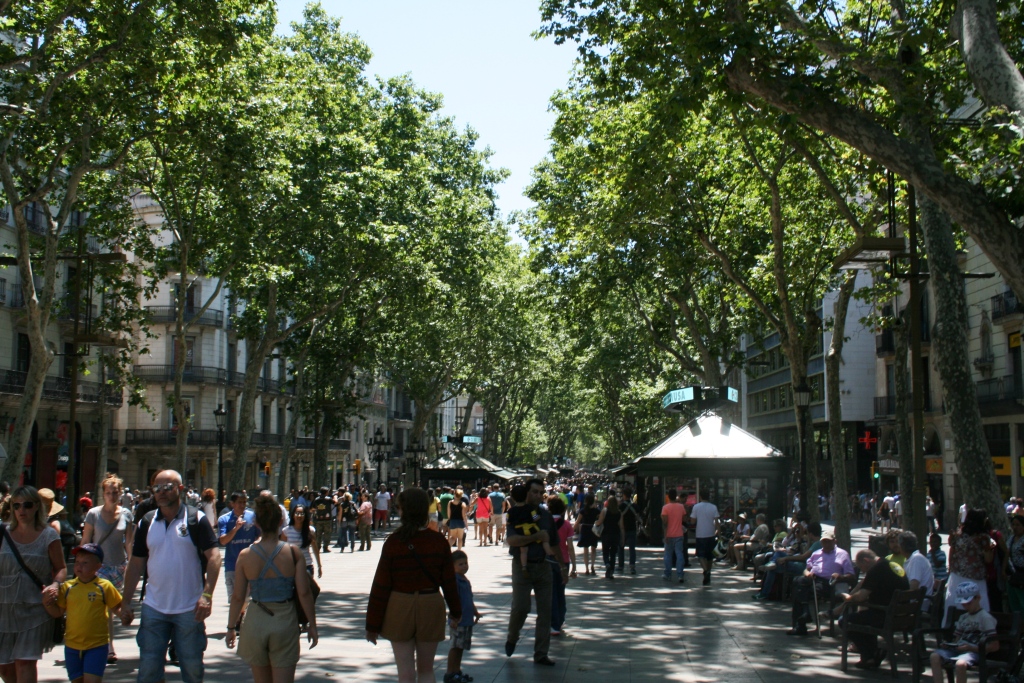
The Rambla of the Capuchins.
This section is also known as La Rambla del Centre. The name comes from an old Capuchin monastery that was on Plaza Reial. Look on your left for the entrance to Plaça Reial, one of the most famous plazas in the Barri Gotic. This part of La Rambla was the first section to be converted into a pedestrian area. On this stretch you can find the Liceu opera house, Gran Theatre del Liceu, and a pavement mosaic art work in the middle of La Rambla, created by Catalan artist Joan Miró
This part of La Rambla in Barcelona takes us down to harbour waterfront and the Cristobal Colon monument (Christopher Columbus in English and Cristòfor Colom in Catalan) built for the 1888 Universal Exposition.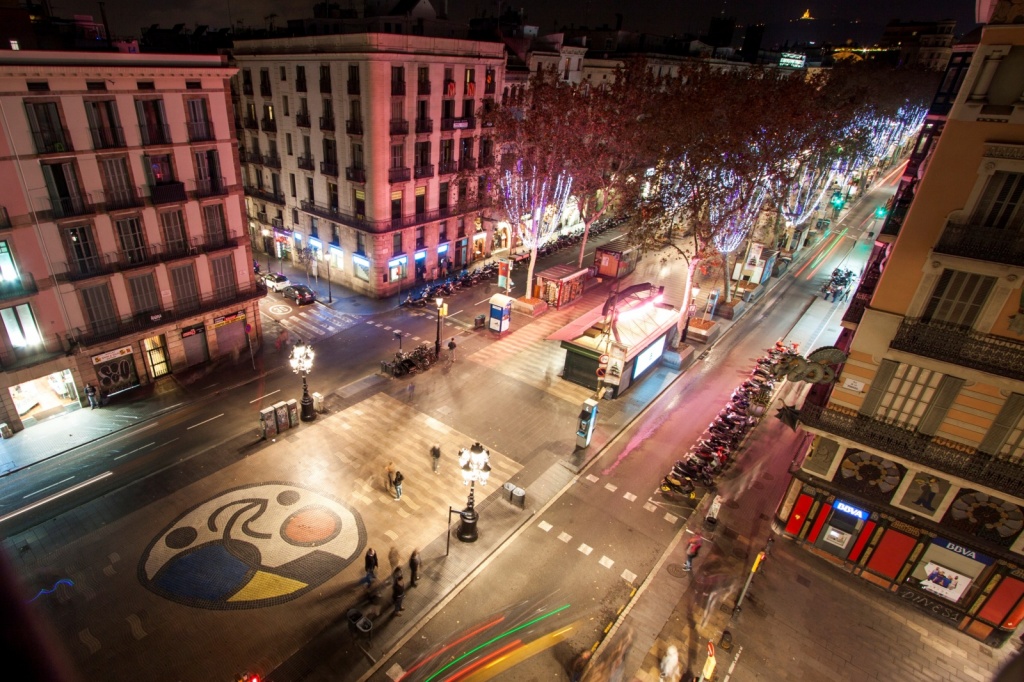
The Rambla of the sea.
In 1992 the 6th section of La Rambla, called La Rambla de Mar, was added which is the walkway out to the Maremagnum shopping center. Next to the Maremagnum mall you can find the popular Barcelona aquarium which is one of the biggest in Europe.
Rambla resources
Pictures of La Rambla
L’Associació d’Amics, Veïns i Comerciants de la Rambla
Ramblejant – La Rambla association blog
Hotels near Las Ramblas
Walking tours Barcelona’s old city
Places to visit on and near Las Ramblas
Liceu opera house
La Boqueria market
Plaça Reial square
Pasteleria Escriba
Palau de la Virreina
Wax museum
This article also answers the questions:
What is the main tourist street in Barcelona?
Where are the most pickpockets in Barcelona?
What is the most famous street in Barcelona?
© Copyright Barcelonayellow.
All rights reserved.
Do not copy text or images on this page without permission
16 Best Things to Do on La Rambla in Barcelona
Discover the best things to do on La Rambla, Barcelona’s most famous street – including art, theatre, shops and delish food
Advertising
Looking for the best things to do on La Rambla? You’ll inevitably wander along Barcelona’s most famous boulevard at some point – so use this as your whistlestop guide.
This 1.2km boulevard starts at Plaça de Catalunya and ends at the statue of Christopher Columbus down by the port. Nowadays, you won’t see any caged animals being sold on La Rambla (this was banned in 2006), but you will notice that its various sections were named after saints (like Santa Mònica, or Sant Josep, whose stretch is also known as La Rambla dels Flors), a reference to the period between the 16th and 18th centuries when the street was lined with churches and convents.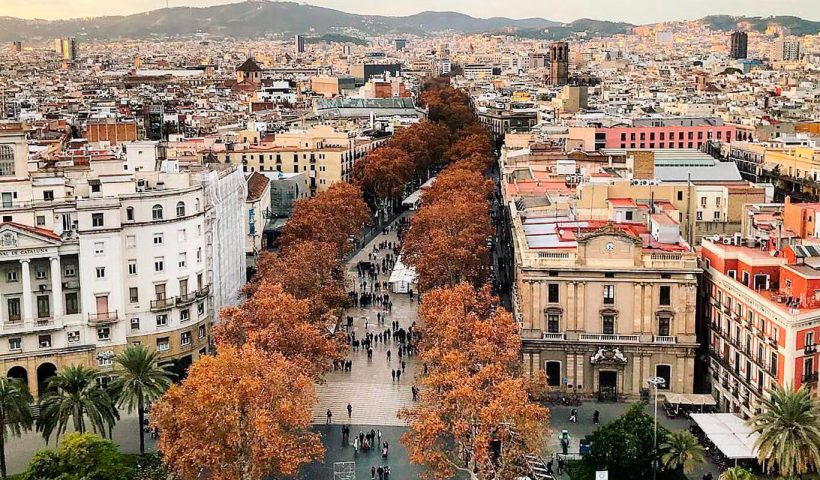
Aimed at long-time Rambla ramblers and first-timers alike, this is your guide to the best things to do, places to shop, restaurants, bars and cafés to stop in, attractions and monuments to admire along a street that’s unlike any other.
RECOMMENDED: Full guide to the best things to do in Barcelona
An email you’ll actually love
Get into a relationship with our newsletter. Discover the best of the city, first.
By entering your email address you agree to our Terms of Use and Privacy Policy and consent to receive emails from Time Out about news, events, offers and partner promotions.
🙌 Awesome, you’re subscribed!
Thanks for subscribing! Look out for your first newsletter in your inbox soon!
Best things to do on La Rambla in Barcelona
Photo: Olivia Rutherford / Time Out
1.

- Shopping
- Markets and fairs
- El Raval
Encircled by the neoclassical Plaça Sant Josep, the Boqueria doesn’t boast the imposing iron superstructure of the Born market, or the grandeur of Sant Antoni. But it’s become the most flamboyant and busiest market in the city, bringing together long-term residents and newcomers, vendors of local produce and importers of exotic delicacies, chefs in search of the finest ingredients and tourists in search of a market-fresh meal or snack. The Boqueria is Barcelona’s true centre of gravity.
Read more
Book online
2. La Rambla dels Flors
- Attractions
- El Raval
Flower-sellers have been adding a splash of colour to La Rambla for centuries. Celebrated in prose by playwright Josep Maria Sagarra, in song by Miquel Porter and Joan Manuel Serrat, and the inspiration for painters like Ramon Casas, the flower-sellers are an essential part of La Rambla’s heritage.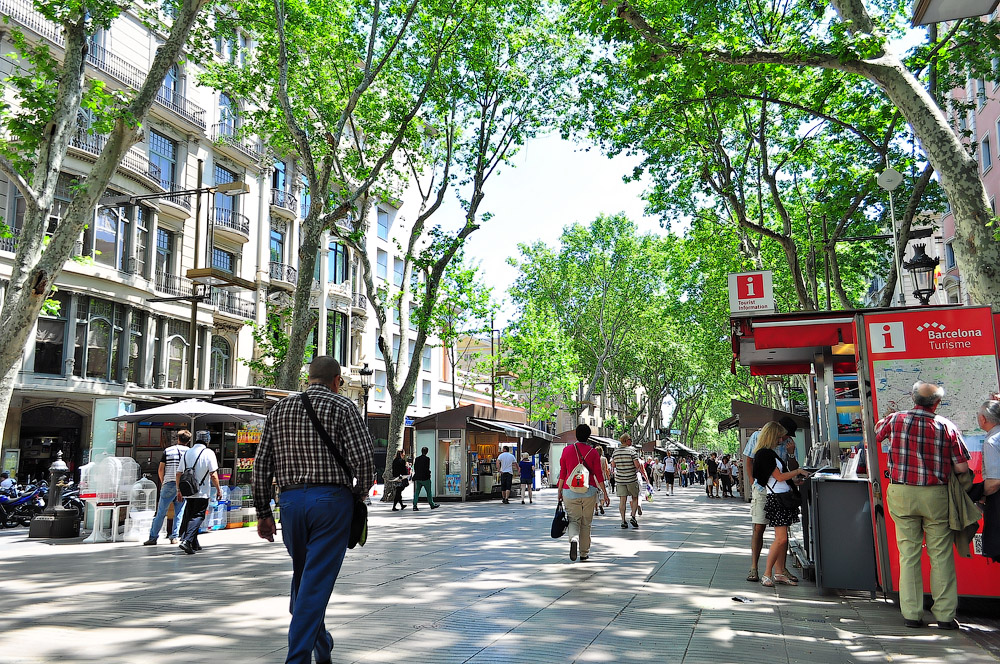
Read more
Advertising
Photo: Antoni Bofill
3. Liceu opera house
- Music
- Music venues
- El Raval
Put your preconceptions aside: a night at the opera can cost less than tickets to see the ‘in’ band of the moment. And though the Gran Teatre del Liceu is known as an opera house, you can also get your culture on with a ballet, and occasionally, indeed, concerts – featuring not just classical but pop music as well. So why not pay a visit to Barcelona’s great temple of song?
Photo: Maria Dias
4. Columbus Monument
- Attractions
- Monuments and memorials
- El Gòtic
It’s a great plan to start at the top of La Rambla and make your way down. Though some are prone to doing the opposite, meaning you can start early in the morning with a climb up the monument to Christopher Columbus (don’t worry, there’s a lift), taking advantage of the quiet morning hours to feast your eyes on the city below: the Gothic Quarter, the Raval, Montjuïc, La Rambla itself, and the glistening Mediterranean.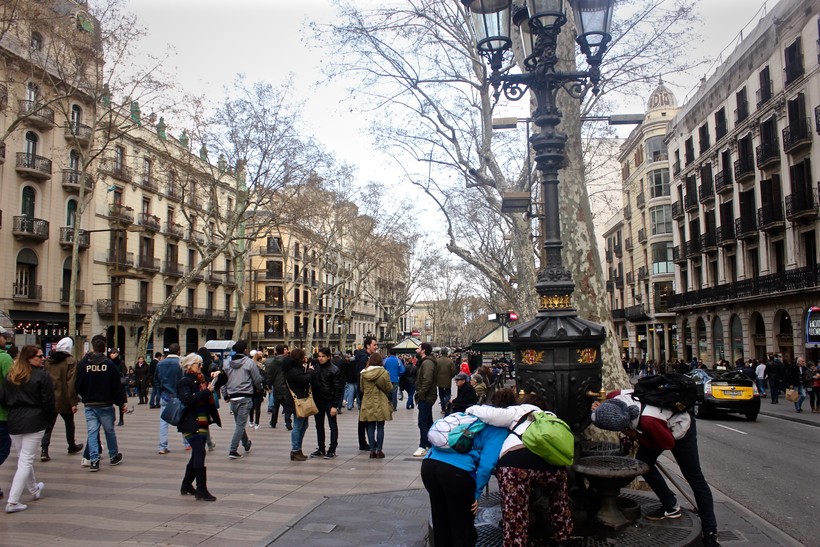
Read more
Advertising
5. Cafè de l’Òpera
- Restaurants
- El Gòtic
Cafè de l’Opera has stood the test of time, still in the same spot on La Rambla where it first opened its doors in 1929. With its lovely stained-glass windows, this café harks back to the days of the old Viennese coffeehouses, and the quality of coffee served is much higher than many modern equivalents. One of Barcelona’s few remaining historical cafés, it opened in the 18th century as a tavern, before being converted to a ‘chocolatería’ a century later. More recently, it’s been treated to a very Barcelona modernista makeover. When the weather suits, there’s nothing better than having chocolate with churros on the terrace and doing some of the best people-watching of your life.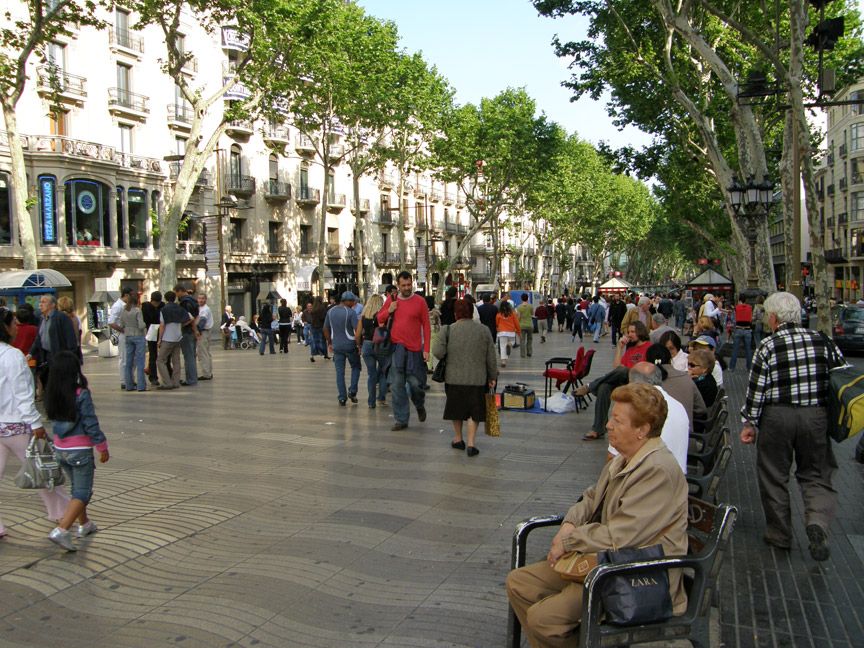
Read more
6. Canaletes fountain
- Attractions
- Ciutat Vella
If you’re having so much fun in Barcelona that you’re already planning your next visit, Canaletes fountain at the top of La Rambla could help make your holiday dreams come true. Legend has it that if you take a drink here, you’re guaranteed to return to Barcelona. The fountain has an interesting history linked to the city’s water supply that dates to the 15th century, and in its more recent past, it’s been a place for Barça fans to gather since 1930 to celebrate their team’s wins. It’s also a popular place for friends to meet when heading into town.
Read more
Advertising
Photo: Shutterstock
7. Miró mosaic
Right in the centre of La Rambla is an enormous mosaic by one of Barcelona’s most famous artists, and you’ve probably already walked over it without even noticing.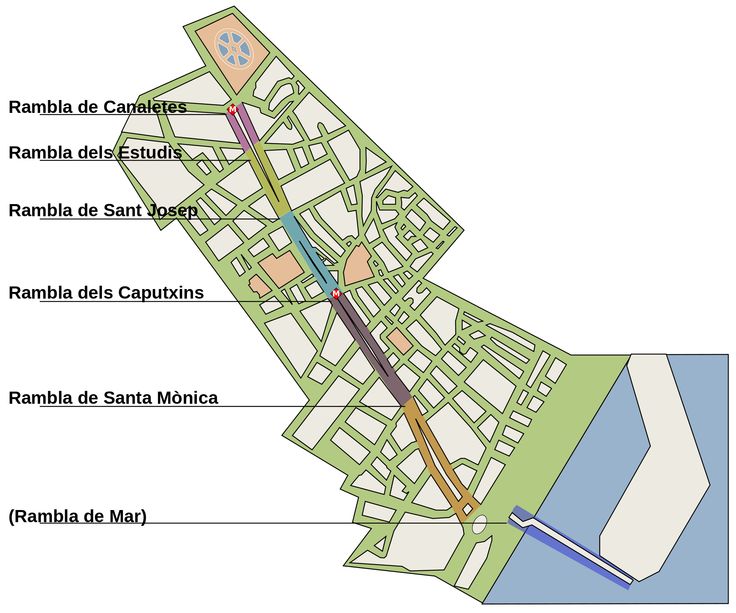
Photo: Marc Andreu
8. 2017 terrorist attack memorial
On August 17, 2017, Barcelona’s most emblematic street fell victim to a terrorist attack that resulted in the death of 15 individuals and over 100 more with injuries. To honour them, on March 4, 2019, the City of Barcelona unveiled a 12-metre-long memorial on La Rambla next to the Joan Miró mosaic, where the speeding van used as a weapon finally came to a stop. The memorial bears a simple message denouncing violence – ‘Peace come upon you, oh city of peace’ – in four languages: Arabic, English, Catalan and Spanish.
Advertising
Foto Christian Escribà
9. Escribà
- Shopping
- Bakeries
- El Raval
For decades, the Antiga Casa Figueras, probably the prettiest modernista shop in the city, was a pasta-makers. In the 1980s it was acquired by the Escribà family, who restored it and turned it into a branch of their patisserie empire: now the cakes on display are as delicate and elaborate as the mosaics on the façade. Morning coffee and a pastry on their terrace in Carrer Petxina are ingredients for a great start to the day. Though don’t feel you have to stop at breakfast.
Read more
Museu de cera
10. Museu de Cera
- Museums
- Ciutat Vella
One of Barcelona’s more quirky museums, the Museu de Cera is this city’s attempt at a wax museum.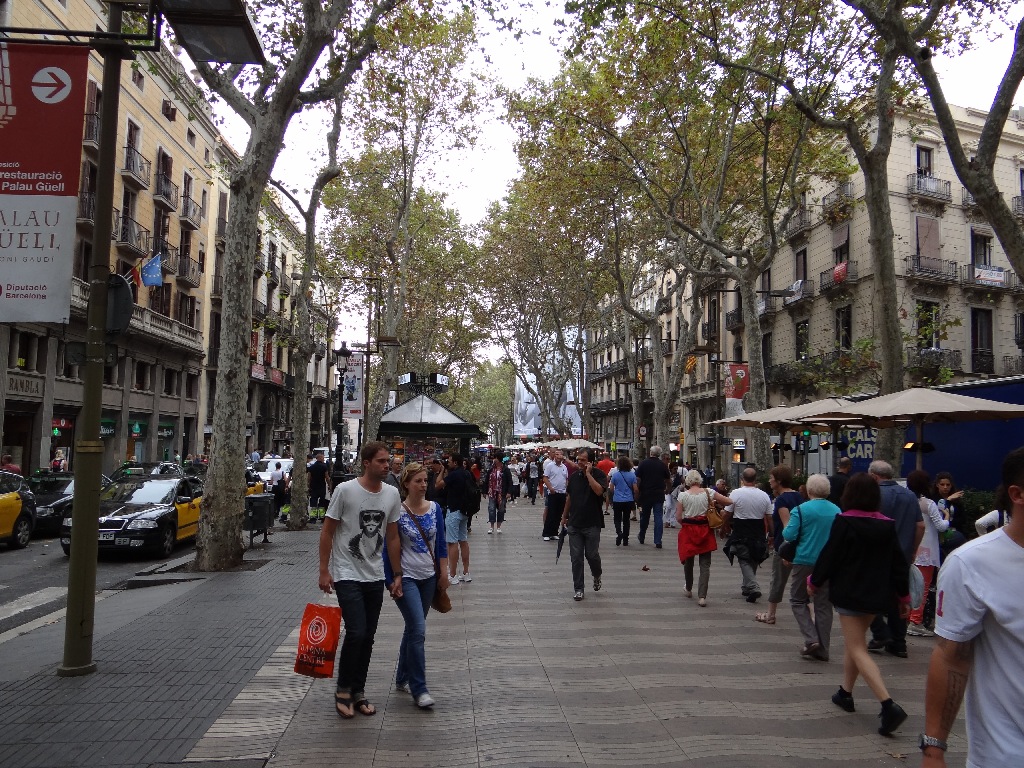
Read more
Advertising
11. La Virreina Centre de la Imatge
- Museums
- Art and design
- El Raval
It’s all about image at La Virreina, located in an 18th-century palace built for a Viceroy of Peru and named for his wife (‘virreina’ is Catalan for vicereine). You’ve got not reason not to stop in and admire the architecture and adorning sculptures, as there’s no admission fee, and that means you get in free as well to the exhibitions.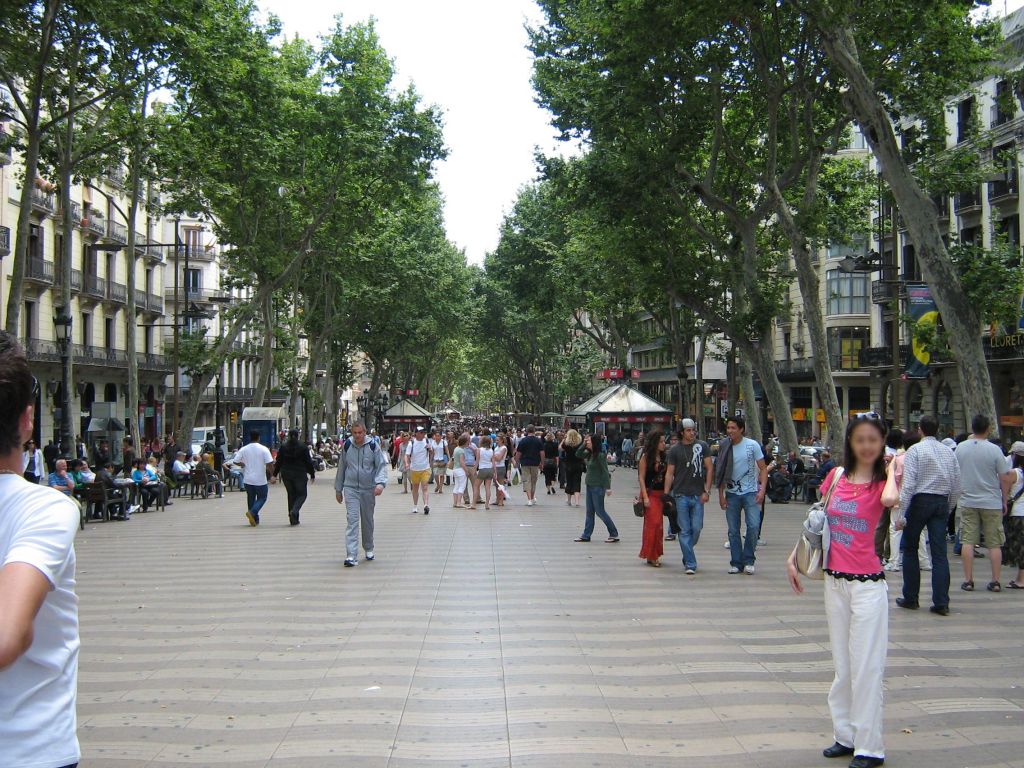
Read more
Photo: Irene Fernández
12. Centro Galego de Barcelona
- Things to do
- Cultural centres
- El Raval
A well-kept secret – unless you happen to have Galician relatives – Barcelona’s Galician Centre (Centro Galego de Barcelona) was established some 70 years ago, in one of the magnificent apartments of the Güell family residence (yes, that family, from the Palau and the Park also named after them). As well as the library and the majestic hall for members’ activities, the CGB has a bar and restaurant where you can try fantastic Galician cooking at extremely reasonable prices.
Read more
Advertising
Photo: Richard Fand/MEB
13.
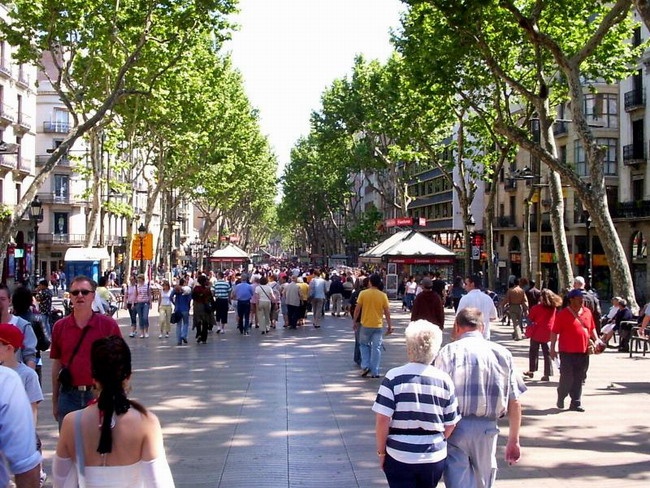
- Attractions
- El Gòtic
One of La Rambla’s more provocative attractions, the Museu de l’Erotica claims to have been set up for educational purposes, as it attempts to teach visitors about the theme of eroticism throughout history. Home to more than 800 pieces, the museum aims to demonstrate how different cultures have understood what’s sexy, through recreational and even religious objects from ancient Roman times to the early 1920s. If you find you’re not so tempted by a side of history rarely covered in conventional textbooks, bear in mind that the museum does offer free cava to its guests.
Read more
Photo: Scott Chasserot
14. Casa Beethoven
- Shopping
- Music and entertainment
- El Raval
Sheet music for flute, harp, organ – classical or modern: if Casa Beethoven doesn’t have it in stock, they’ll find it for you. Tucked away round the corner from the Palau de la Virreina, this is one of the city’s musical treasures, a fixture since 1880.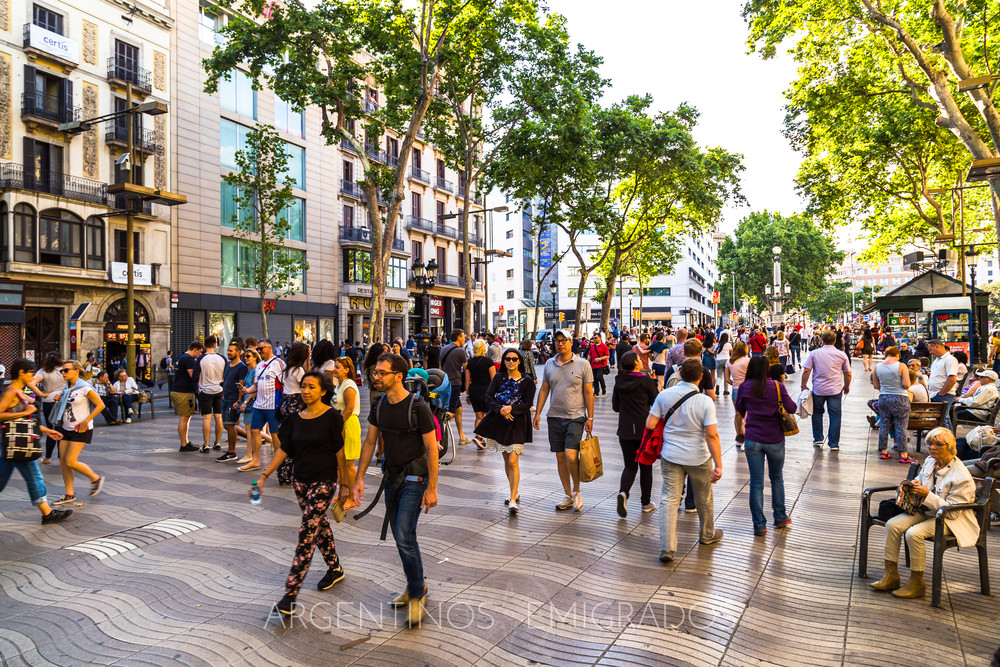
Read more
Advertising
15. Poliorama Theatre
- Theatre
- Comedy
- El Raval
The building where the Poliorama Theatre now stands first opened in 1899 as a cinema, and changed hats over the years until it ended up as a theatre in 1982. Though you might feel your Catalan or Spanish skills aren’t up to snuff to enjoy a full theatre play, check the schedule for performances where no language knowledge is required, including concerts, flamenco shows, or visual comedy acts.
Read more
Buy ticket
16. Arts Santa Mònica
- Museums
- Art and design
- El Raval
It’s not one of the city’s most important museums, but if you’re strolling along La Rambla and you fancy a bit of local art, drop in to Arts Santa Mònica.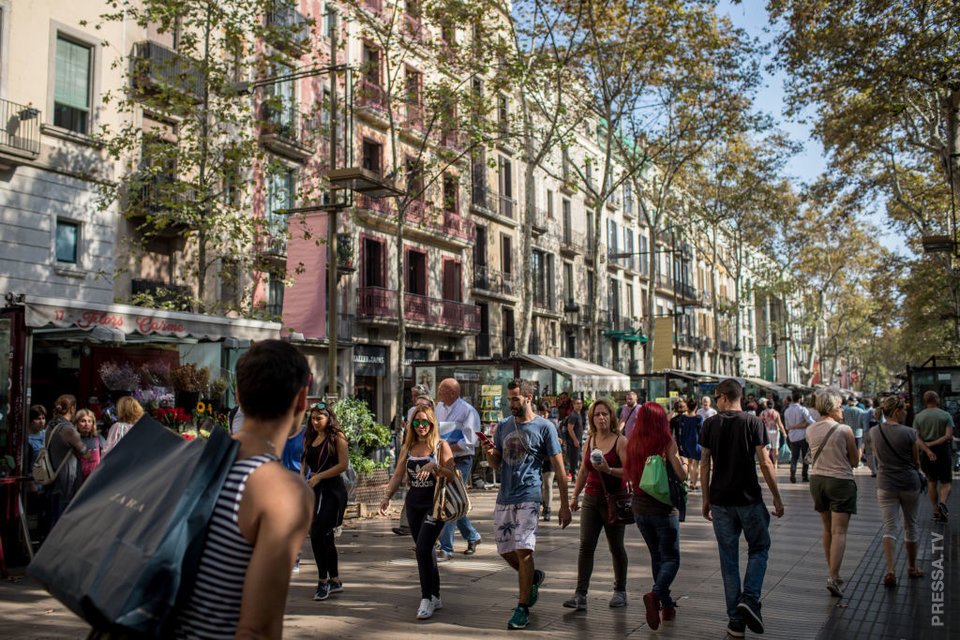
Read more
Buy ticket
Looking for somewhere to eat nearby?
Photo: Maria Dias
The 10 best restaurants near La Rambla
- Restaurants
Don’t fall for some of the overpriced and low-quality tapas and paella offered along La Rambla. Instead, take a few steps away from the tourist bustle to check out these restaurants just moments from the action.
Read more
Show more
An email you’ll actually love
Get into a relationship with our newsletter.
By entering your email address you agree to our Terms of Use and Privacy Policy and consent to receive emails from Time Out about news, events, offers and partner promotions.
🙌 Awesome, you’re subscribed!
Thanks for subscribing! Look out for your first newsletter in your inbox soon!
An email you’ll actually love
Get into a relationship with our newsletter. Discover the best of the city, first.
Déjà vu! We already have this email. Try another?
By entering your email address you agree to our Terms of Use and Privacy Policy and consent to receive emails from Time Out about news, events, offers and partner promotions.
🙌 Awesome, you’re subscribed!
Thanks for subscribing! Look out for your first newsletter in your inbox soon!
Recommended
[image]
[title]
You may also like
You may also like
Advertising
Ramblas ~ Guide in Barcelona Sofia
About Barcelona and Catalonia
gidsofiaComment(0)
Las Ramblas is the most famous street in Barcelona.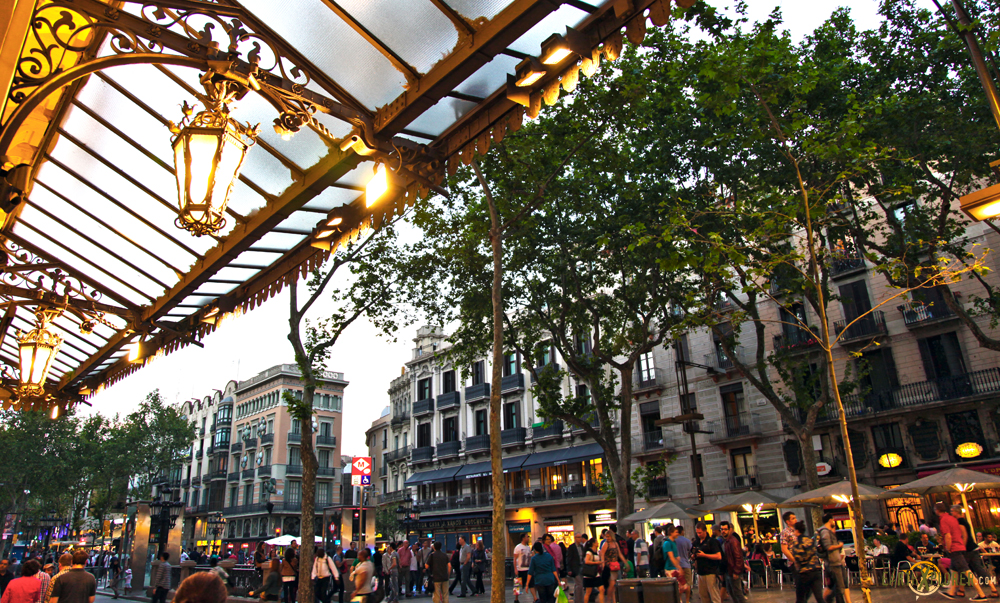
“This is the most beautiful street in the world” . So the English writer Somerset Maugham spoke about the main street of Barcelona. Indeed, Barcelona’s Las Ramblas is one of the most famous streets not only in the Catalan capital, but throughout Spain.
This is a long pedestrian street lined with tall trees and shaded by plane trees. The Ramblas starts from Plaza Catalunya and ends at Plaza Portal de la Pau, which leads to the waterfront. The length of the boulevard is 1180 meters. The word “ rambla ” comes from the Arabic “ram-la” which means “bed of a dried up river”.
In fact, the Ramblas is not one street, but as many as five, having a different look and name and passing one into another.
The second street is called Rambla Teachings (Rambla dels Estudis) in honor of the university that was once located here. The main decorations of this part of the street is the Baroque Church of Our Lady Bethlehem and Mozha Palace.
The third section of the Rambla is called St. Joseph’s Rambla (Rambla de San Josep), but more often it is called “ Flower Rambla” because of the many flower stalls located in this part of the street.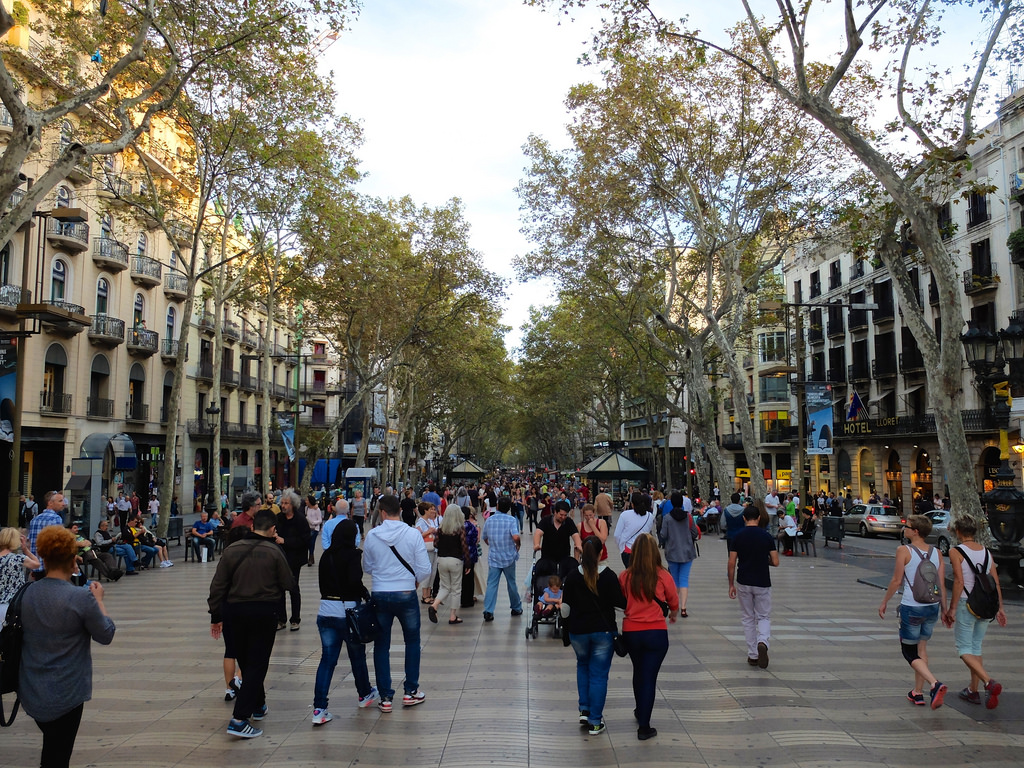
This part of the boulevard is famous for its location of the Boquería Central Market and the Viceroy’s Palace.
The fourth section is called the Rambla of the Capuchins, but these days it is more common to hear “Theatrical Rambla “. As you might guess, city theaters are located here, the most famous of which is the Liceu Opera House.
Rambla de Santa Monica is the last section of the boulevard, it will take you to the statue of Columbus and the waterfront of the old port.
This place is chosen by Barcelona “living statues” – actors who skillfully transform into various characters.
4* Hotel España – the pearl of Catalan modernism
The 4-star Hotel España is located on Sant Pau, in the historic center of Barcelona near the central Las Ramblas, the Liceu Opera House (Gran Teatre del Liceu), the La Boquería market and many attractions that make Barcelona one of the most cosmopolitan cities in Europe.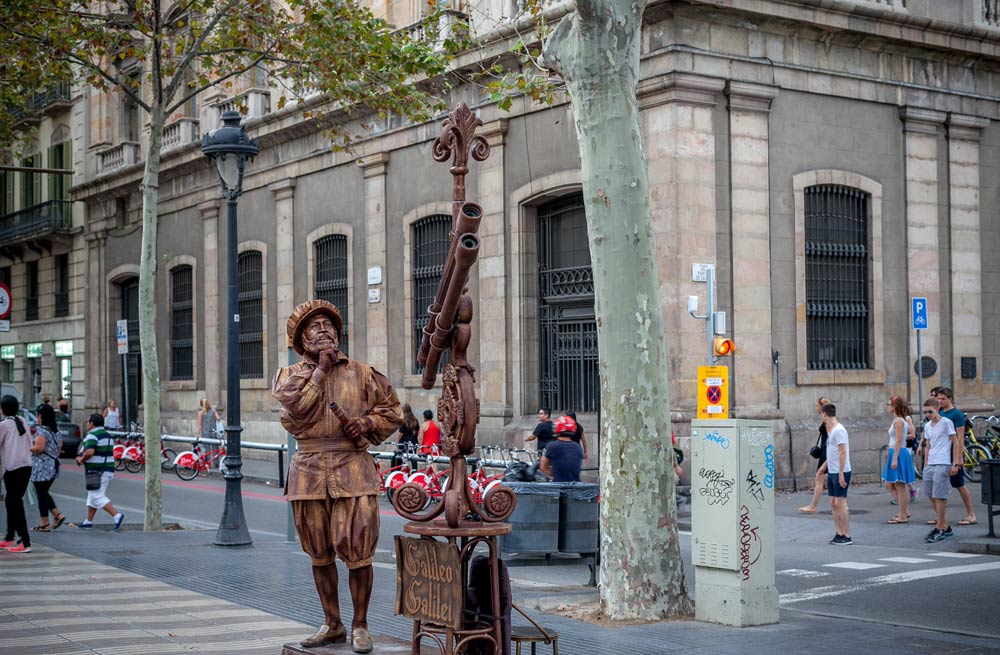
You can also take the metro or buses, which require a bit of a walk as they all leave from Plaça Catalunya. Barcelona has an excellent public transport system, making it easy to get to the metro from your hotel in central Barcelona.
LOCATION
Despite its size, getting around Barcelona is quite easy. Staying in a hotel in the center of Barcelona, you can reach the main tourist attractions on foot.
Art, history and design
The Hotel España is considered the jewel of Catalan modernism. The hotel was opened in 1859 under the name Fonda España. Later, at the beginning of the 20th century, the hotel was renovated by the famous modernist architect Luis Domènech y Montaner, in collaboration with the sculptor Eusebi Arnau and the painter Ramon Casas.
The renovation of the hotel in 2010 restored the spirit that Domènech i Montaner embodied in his work.
Fonda España
The restaurant is an Art Nouveau room, originally designed and designed by the architect Domènech i Montaner, which served as the historical basis for the recent renovation.
Restaurante Fonda España
Services
The hotel offers 82 comfortable rooms. It also houses the restaurant “Fonda España” under the direction of the famous chef Martin Berasategui (12 Michelin stars), the bar “Arnau” and the terrace “Alaire Ramblas”.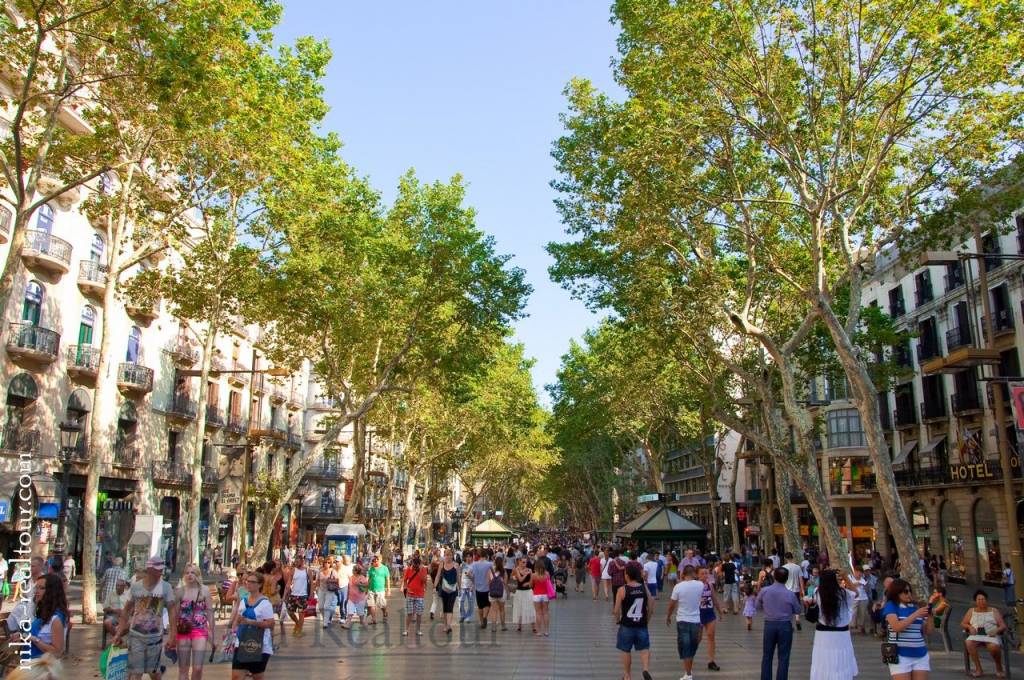
Solarium and swimming pool
The outdoor swimming pool is located on the roof of the hotel and offers panoramic views of Barcelona’s Old Town (Ciutat Vella). Spacious solarium with sun loungers where you can relax right in the city centre. Open from May to October.
OTHER SERVICES
free PressReader, gym next to the hotel, free WiFi, business center, conference rooms, banquet rooms.
Bar “Arnau” (Arnau)
The bar is named after the famous sculptor Eusebi Arnau. His creation is a magnificent alabaster fireplace located in the center of the hall.
The interior combines modernist elements with contemporary design.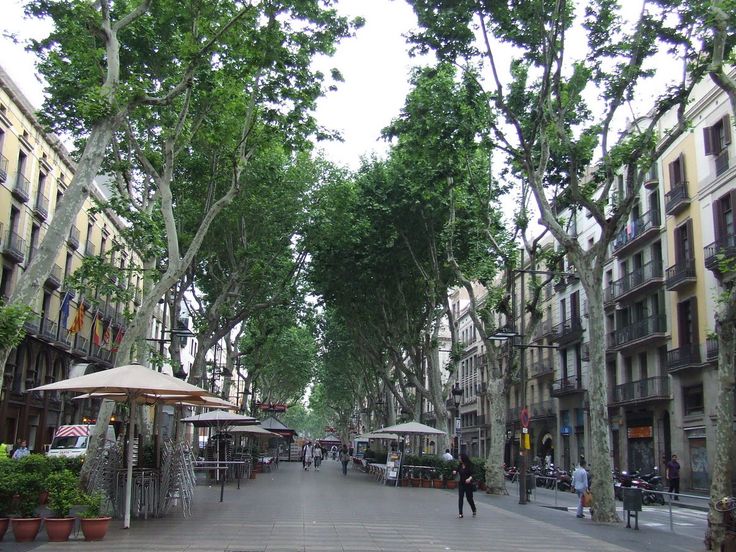
A favorite meeting place for the city’s residents, where you can enjoy the best aperitifs, cocktails in a unique and hospitable environment.
The bar menu offers a wide selection of snacks.
YOUR HOTEL IN LAS RAMBLAS, IN THE HEART OF BARCELONA
Barcelona is one of those European cities with a central axis. The central axis of Barcelona is Las Ramblas, a very long pedestrian street that is very popular with both locals and visitors to the city. It runs between Plaça Catalunya and the old port known as Port Vel. This is one of the many reasons why it is important to choose the hotel located at Las Ramblas. Hotel España is located in the heart of Las Ramblas, just a few steps from Plaza Catalunya and the city’s main attractions.
When you come to Barcelona, you will certainly want to see the magnificent Gaudí buildings, the Sagrada Familia, the Gothic Quarter, the lively markets, museums, the promenade and the beaches.

